Foundation of Law: Assignment Solutions and Analysis
VerifiedAdded on 2022/10/11
|7
|1482
|7
Homework Assignment
AI Summary
This assignment provides detailed answers to questions about the foundation of law, focusing on the Australian legal system. It explores the relationship between law and power, the organization of legal statutes, and the differences between public, private, criminal, civil, domestic, and international law. The assignment also examines the evolution of law, the structure of the Australian legal system, its historical development, and the separation of powers under the Constitution. The answers cover the different courts, their jurisdictions, and the key features of the common law system inherited from British colonizers. The assignment provides a comprehensive overview of the Australian legal framework, including references to relevant legal concepts and cases.
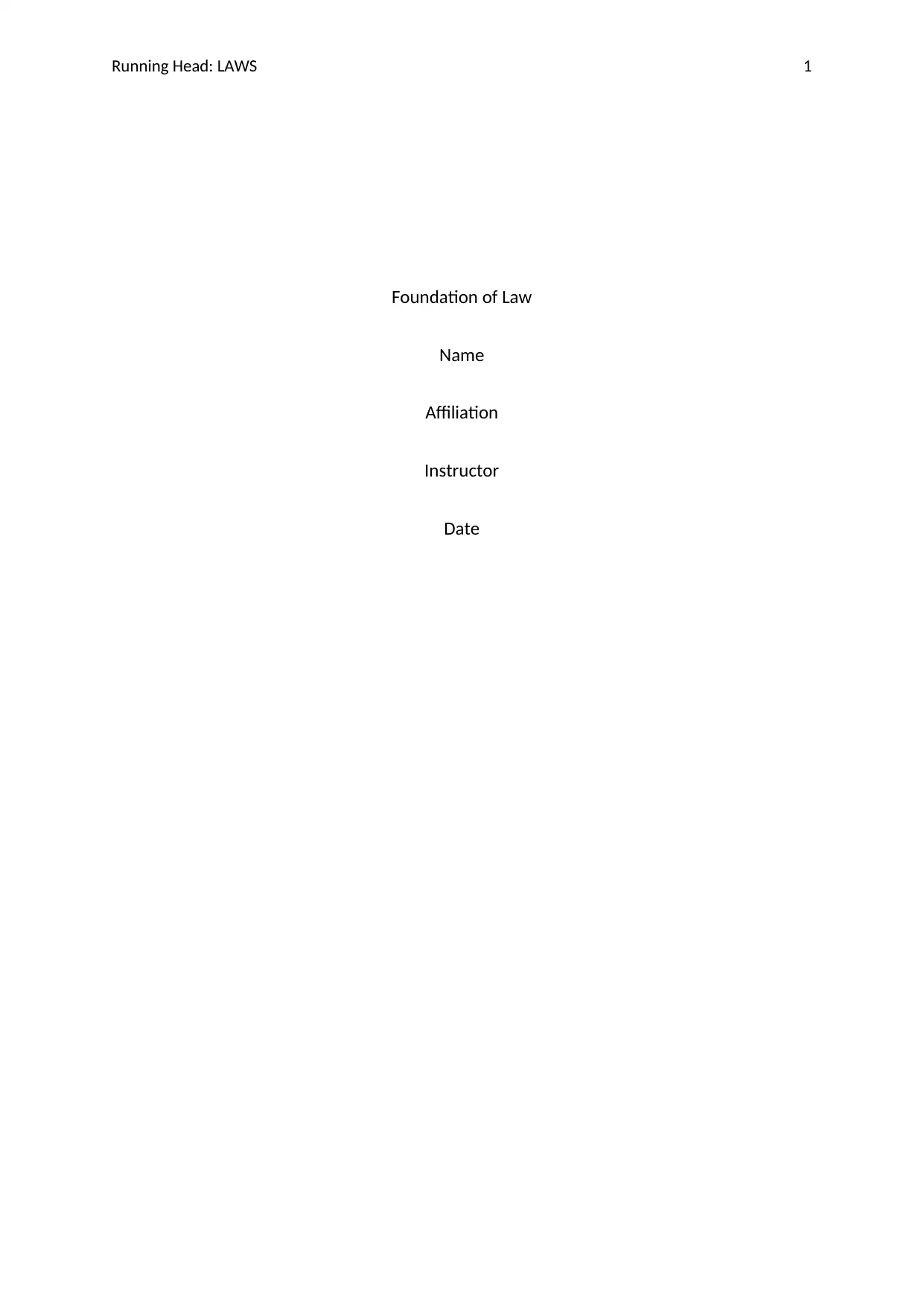
Running Head: LAWS 1
Foundation of Law
Name
Affiliation
Instructor
Date
Foundation of Law
Name
Affiliation
Instructor
Date
Paraphrase This Document
Need a fresh take? Get an instant paraphrase of this document with our AI Paraphraser
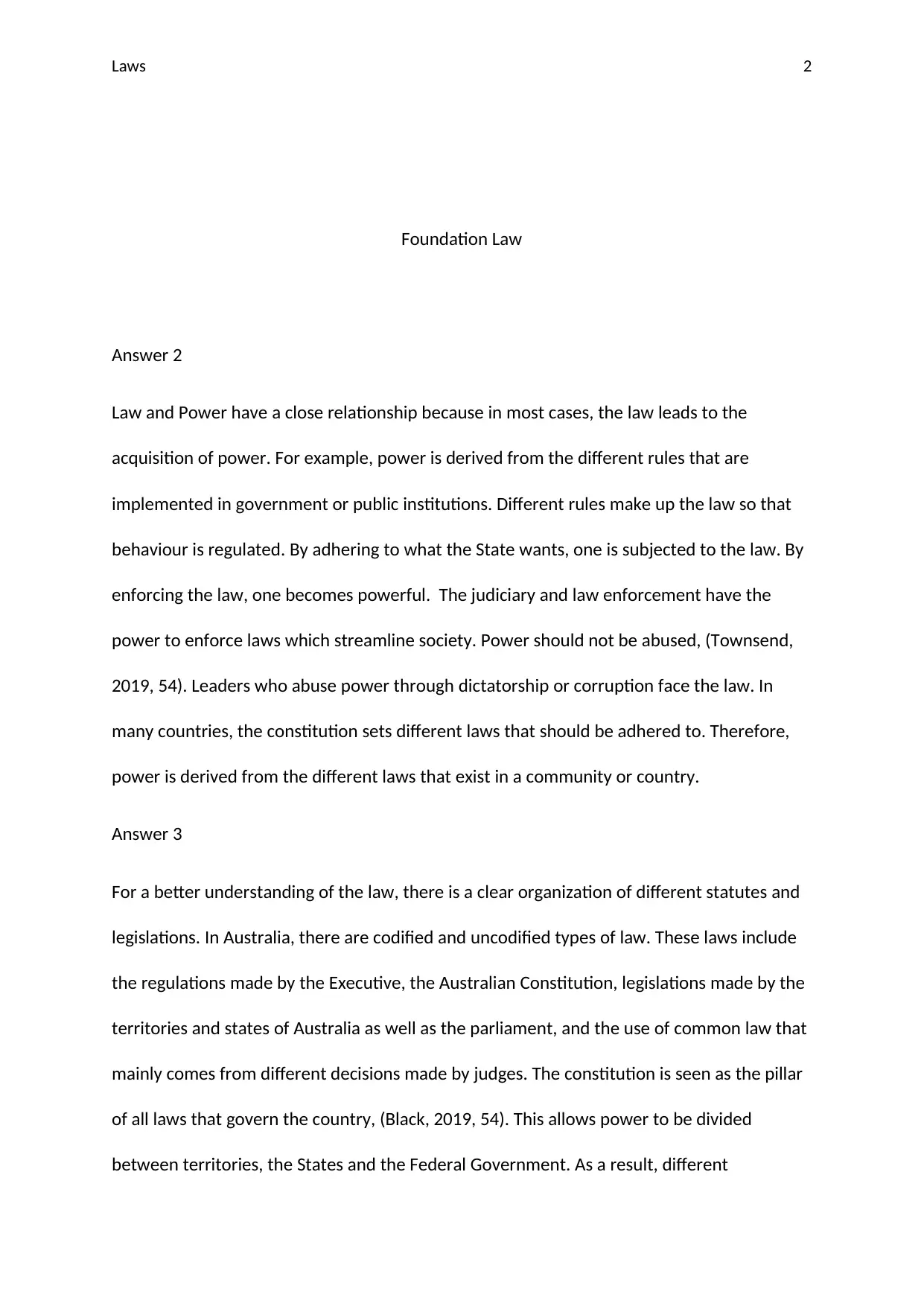
Laws 2
Foundation Law
Answer 2
Law and Power have a close relationship because in most cases, the law leads to the
acquisition of power. For example, power is derived from the different rules that are
implemented in government or public institutions. Different rules make up the law so that
behaviour is regulated. By adhering to what the State wants, one is subjected to the law. By
enforcing the law, one becomes powerful. The judiciary and law enforcement have the
power to enforce laws which streamline society. Power should not be abused, (Townsend,
2019, 54). Leaders who abuse power through dictatorship or corruption face the law. In
many countries, the constitution sets different laws that should be adhered to. Therefore,
power is derived from the different laws that exist in a community or country.
Answer 3
For a better understanding of the law, there is a clear organization of different statutes and
legislations. In Australia, there are codified and uncodified types of law. These laws include
the regulations made by the Executive, the Australian Constitution, legislations made by the
territories and states of Australia as well as the parliament, and the use of common law that
mainly comes from different decisions made by judges. The constitution is seen as the pillar
of all laws that govern the country, (Black, 2019, 54). This allows power to be divided
between territories, the States and the Federal Government. As a result, different
Foundation Law
Answer 2
Law and Power have a close relationship because in most cases, the law leads to the
acquisition of power. For example, power is derived from the different rules that are
implemented in government or public institutions. Different rules make up the law so that
behaviour is regulated. By adhering to what the State wants, one is subjected to the law. By
enforcing the law, one becomes powerful. The judiciary and law enforcement have the
power to enforce laws which streamline society. Power should not be abused, (Townsend,
2019, 54). Leaders who abuse power through dictatorship or corruption face the law. In
many countries, the constitution sets different laws that should be adhered to. Therefore,
power is derived from the different laws that exist in a community or country.
Answer 3
For a better understanding of the law, there is a clear organization of different statutes and
legislations. In Australia, there are codified and uncodified types of law. These laws include
the regulations made by the Executive, the Australian Constitution, legislations made by the
territories and states of Australia as well as the parliament, and the use of common law that
mainly comes from different decisions made by judges. The constitution is seen as the pillar
of all laws that govern the country, (Black, 2019, 54). This allows power to be divided
between territories, the States and the Federal Government. As a result, different
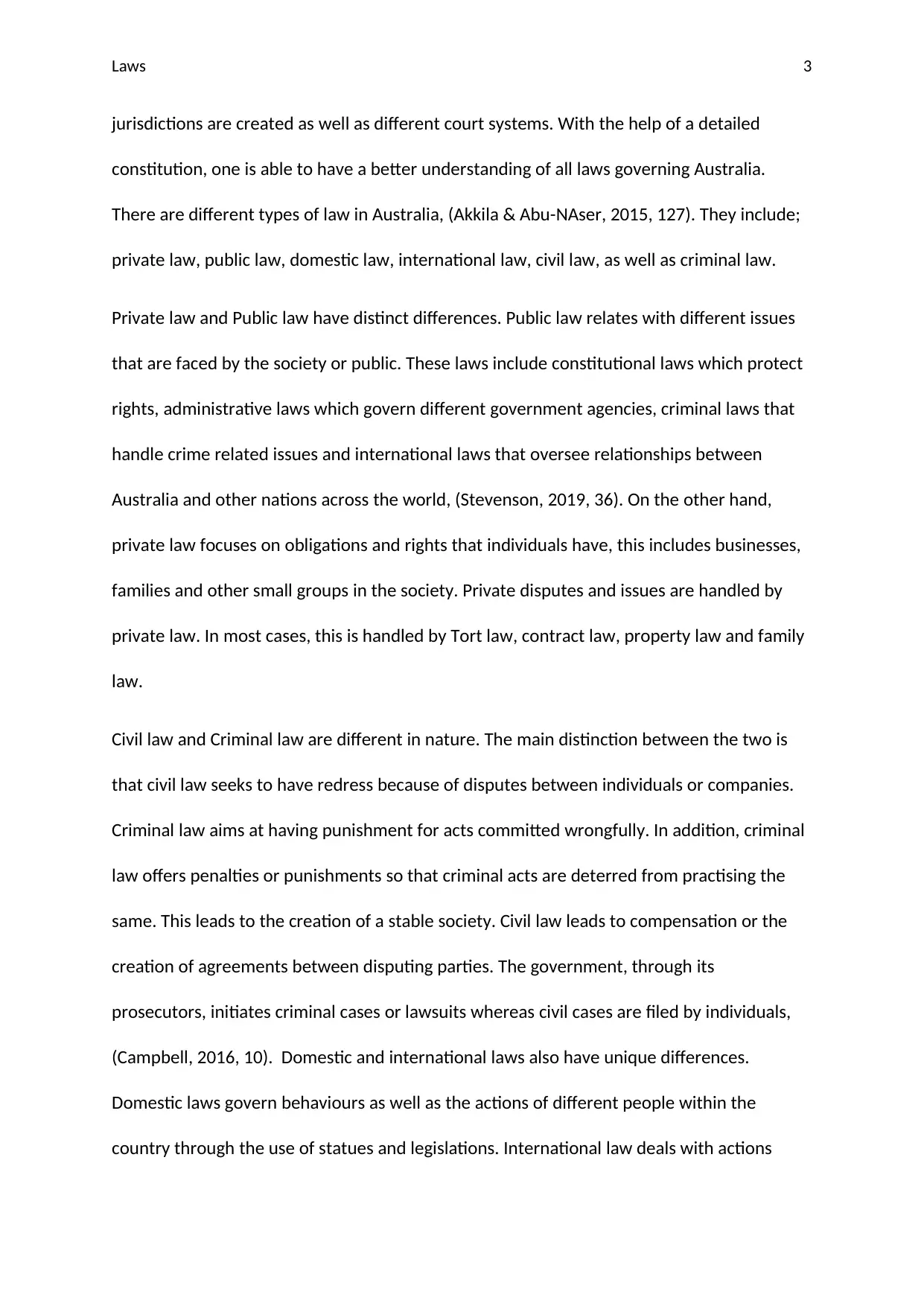
Laws 3
jurisdictions are created as well as different court systems. With the help of a detailed
constitution, one is able to have a better understanding of all laws governing Australia.
There are different types of law in Australia, (Akkila & Abu-NAser, 2015, 127). They include;
private law, public law, domestic law, international law, civil law, as well as criminal law.
Private law and Public law have distinct differences. Public law relates with different issues
that are faced by the society or public. These laws include constitutional laws which protect
rights, administrative laws which govern different government agencies, criminal laws that
handle crime related issues and international laws that oversee relationships between
Australia and other nations across the world, (Stevenson, 2019, 36). On the other hand,
private law focuses on obligations and rights that individuals have, this includes businesses,
families and other small groups in the society. Private disputes and issues are handled by
private law. In most cases, this is handled by Tort law, contract law, property law and family
law.
Civil law and Criminal law are different in nature. The main distinction between the two is
that civil law seeks to have redress because of disputes between individuals or companies.
Criminal law aims at having punishment for acts committed wrongfully. In addition, criminal
law offers penalties or punishments so that criminal acts are deterred from practising the
same. This leads to the creation of a stable society. Civil law leads to compensation or the
creation of agreements between disputing parties. The government, through its
prosecutors, initiates criminal cases or lawsuits whereas civil cases are filed by individuals,
(Campbell, 2016, 10). Domestic and international laws also have unique differences.
Domestic laws govern behaviours as well as the actions of different people within the
country through the use of statues and legislations. International law deals with actions
jurisdictions are created as well as different court systems. With the help of a detailed
constitution, one is able to have a better understanding of all laws governing Australia.
There are different types of law in Australia, (Akkila & Abu-NAser, 2015, 127). They include;
private law, public law, domestic law, international law, civil law, as well as criminal law.
Private law and Public law have distinct differences. Public law relates with different issues
that are faced by the society or public. These laws include constitutional laws which protect
rights, administrative laws which govern different government agencies, criminal laws that
handle crime related issues and international laws that oversee relationships between
Australia and other nations across the world, (Stevenson, 2019, 36). On the other hand,
private law focuses on obligations and rights that individuals have, this includes businesses,
families and other small groups in the society. Private disputes and issues are handled by
private law. In most cases, this is handled by Tort law, contract law, property law and family
law.
Civil law and Criminal law are different in nature. The main distinction between the two is
that civil law seeks to have redress because of disputes between individuals or companies.
Criminal law aims at having punishment for acts committed wrongfully. In addition, criminal
law offers penalties or punishments so that criminal acts are deterred from practising the
same. This leads to the creation of a stable society. Civil law leads to compensation or the
creation of agreements between disputing parties. The government, through its
prosecutors, initiates criminal cases or lawsuits whereas civil cases are filed by individuals,
(Campbell, 2016, 10). Domestic and international laws also have unique differences.
Domestic laws govern behaviours as well as the actions of different people within the
country through the use of statues and legislations. International law deals with actions
⊘ This is a preview!⊘
Do you want full access?
Subscribe today to unlock all pages.

Trusted by 1+ million students worldwide
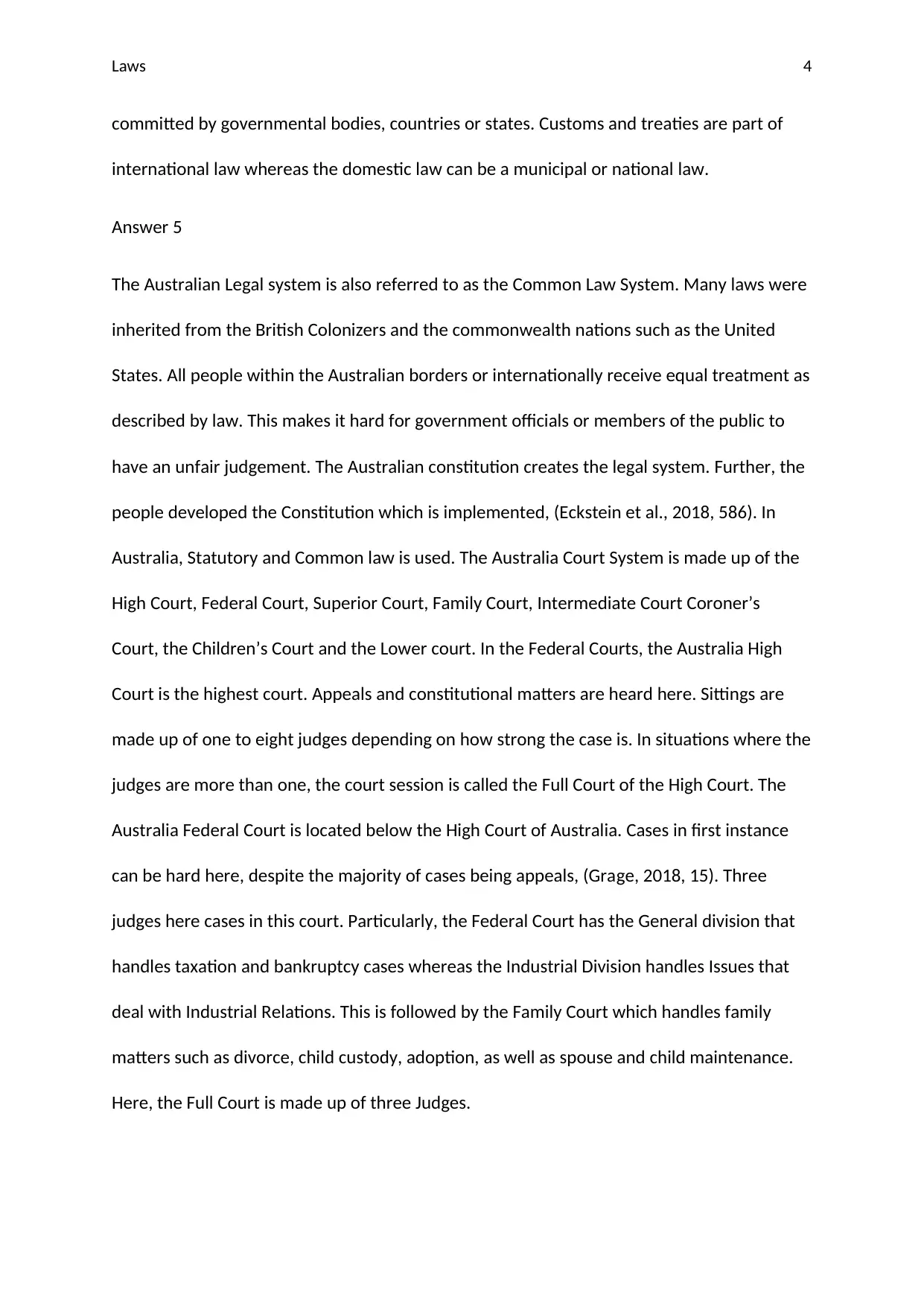
Laws 4
committed by governmental bodies, countries or states. Customs and treaties are part of
international law whereas the domestic law can be a municipal or national law.
Answer 5
The Australian Legal system is also referred to as the Common Law System. Many laws were
inherited from the British Colonizers and the commonwealth nations such as the United
States. All people within the Australian borders or internationally receive equal treatment as
described by law. This makes it hard for government officials or members of the public to
have an unfair judgement. The Australian constitution creates the legal system. Further, the
people developed the Constitution which is implemented, (Eckstein et al., 2018, 586). In
Australia, Statutory and Common law is used. The Australia Court System is made up of the
High Court, Federal Court, Superior Court, Family Court, Intermediate Court Coroner’s
Court, the Children’s Court and the Lower court. In the Federal Courts, the Australia High
Court is the highest court. Appeals and constitutional matters are heard here. Sittings are
made up of one to eight judges depending on how strong the case is. In situations where the
judges are more than one, the court session is called the Full Court of the High Court. The
Australia Federal Court is located below the High Court of Australia. Cases in first instance
can be hard here, despite the majority of cases being appeals, (Grage, 2018, 15). Three
judges here cases in this court. Particularly, the Federal Court has the General division that
handles taxation and bankruptcy cases whereas the Industrial Division handles Issues that
deal with Industrial Relations. This is followed by the Family Court which handles family
matters such as divorce, child custody, adoption, as well as spouse and child maintenance.
Here, the Full Court is made up of three Judges.
committed by governmental bodies, countries or states. Customs and treaties are part of
international law whereas the domestic law can be a municipal or national law.
Answer 5
The Australian Legal system is also referred to as the Common Law System. Many laws were
inherited from the British Colonizers and the commonwealth nations such as the United
States. All people within the Australian borders or internationally receive equal treatment as
described by law. This makes it hard for government officials or members of the public to
have an unfair judgement. The Australian constitution creates the legal system. Further, the
people developed the Constitution which is implemented, (Eckstein et al., 2018, 586). In
Australia, Statutory and Common law is used. The Australia Court System is made up of the
High Court, Federal Court, Superior Court, Family Court, Intermediate Court Coroner’s
Court, the Children’s Court and the Lower court. In the Federal Courts, the Australia High
Court is the highest court. Appeals and constitutional matters are heard here. Sittings are
made up of one to eight judges depending on how strong the case is. In situations where the
judges are more than one, the court session is called the Full Court of the High Court. The
Australia Federal Court is located below the High Court of Australia. Cases in first instance
can be hard here, despite the majority of cases being appeals, (Grage, 2018, 15). Three
judges here cases in this court. Particularly, the Federal Court has the General division that
handles taxation and bankruptcy cases whereas the Industrial Division handles Issues that
deal with Industrial Relations. This is followed by the Family Court which handles family
matters such as divorce, child custody, adoption, as well as spouse and child maintenance.
Here, the Full Court is made up of three Judges.
Paraphrase This Document
Need a fresh take? Get an instant paraphrase of this document with our AI Paraphraser
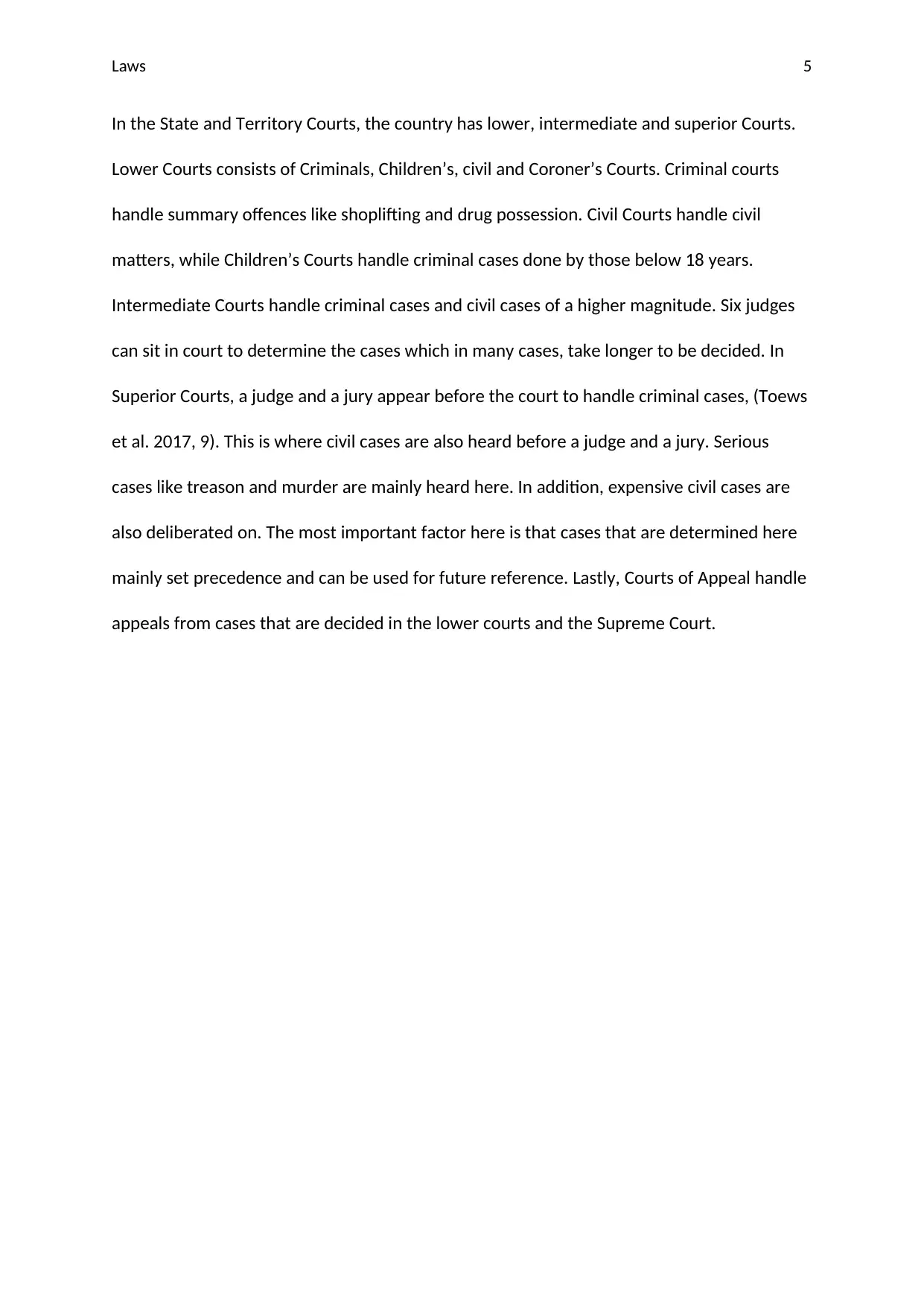
Laws 5
In the State and Territory Courts, the country has lower, intermediate and superior Courts.
Lower Courts consists of Criminals, Children’s, civil and Coroner’s Courts. Criminal courts
handle summary offences like shoplifting and drug possession. Civil Courts handle civil
matters, while Children’s Courts handle criminal cases done by those below 18 years.
Intermediate Courts handle criminal cases and civil cases of a higher magnitude. Six judges
can sit in court to determine the cases which in many cases, take longer to be decided. In
Superior Courts, a judge and a jury appear before the court to handle criminal cases, (Toews
et al. 2017, 9). This is where civil cases are also heard before a judge and a jury. Serious
cases like treason and murder are mainly heard here. In addition, expensive civil cases are
also deliberated on. The most important factor here is that cases that are determined here
mainly set precedence and can be used for future reference. Lastly, Courts of Appeal handle
appeals from cases that are decided in the lower courts and the Supreme Court.
In the State and Territory Courts, the country has lower, intermediate and superior Courts.
Lower Courts consists of Criminals, Children’s, civil and Coroner’s Courts. Criminal courts
handle summary offences like shoplifting and drug possession. Civil Courts handle civil
matters, while Children’s Courts handle criminal cases done by those below 18 years.
Intermediate Courts handle criminal cases and civil cases of a higher magnitude. Six judges
can sit in court to determine the cases which in many cases, take longer to be decided. In
Superior Courts, a judge and a jury appear before the court to handle criminal cases, (Toews
et al. 2017, 9). This is where civil cases are also heard before a judge and a jury. Serious
cases like treason and murder are mainly heard here. In addition, expensive civil cases are
also deliberated on. The most important factor here is that cases that are determined here
mainly set precedence and can be used for future reference. Lastly, Courts of Appeal handle
appeals from cases that are decided in the lower courts and the Supreme Court.
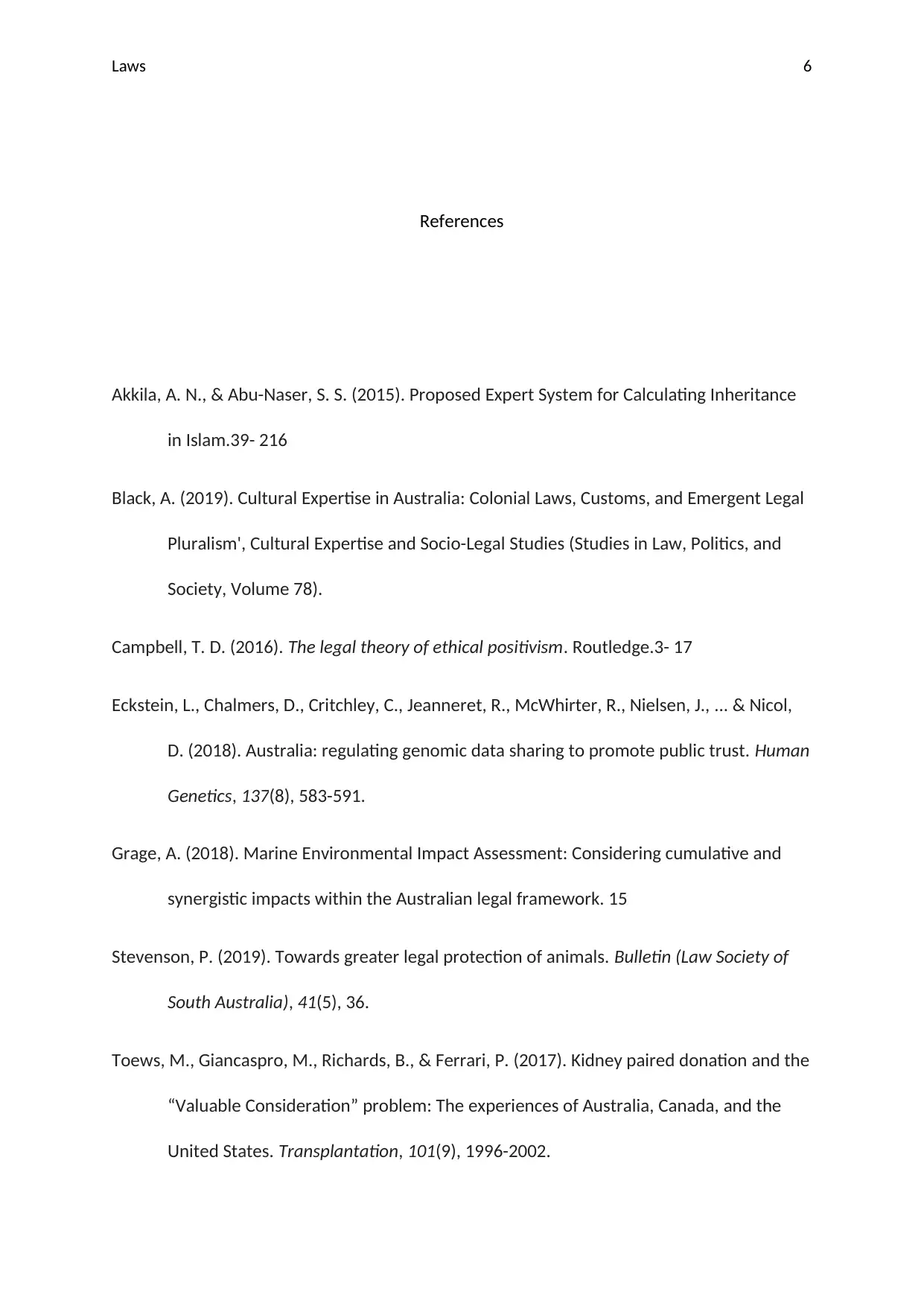
Laws 6
References
Akkila, A. N., & Abu-Naser, S. S. (2015). Proposed Expert System for Calculating Inheritance
in Islam.39- 216
Black, A. (2019). Cultural Expertise in Australia: Colonial Laws, Customs, and Emergent Legal
Pluralism', Cultural Expertise and Socio-Legal Studies (Studies in Law, Politics, and
Society, Volume 78).
Campbell, T. D. (2016). The legal theory of ethical positivism. Routledge.3- 17
Eckstein, L., Chalmers, D., Critchley, C., Jeanneret, R., McWhirter, R., Nielsen, J., ... & Nicol,
D. (2018). Australia: regulating genomic data sharing to promote public trust. Human
Genetics, 137(8), 583-591.
Grage, A. (2018). Marine Environmental Impact Assessment: Considering cumulative and
synergistic impacts within the Australian legal framework. 15
Stevenson, P. (2019). Towards greater legal protection of animals. Bulletin (Law Society of
South Australia), 41(5), 36.
Toews, M., Giancaspro, M., Richards, B., & Ferrari, P. (2017). Kidney paired donation and the
“Valuable Consideration” problem: The experiences of Australia, Canada, and the
United States. Transplantation, 101(9), 1996-2002.
References
Akkila, A. N., & Abu-Naser, S. S. (2015). Proposed Expert System for Calculating Inheritance
in Islam.39- 216
Black, A. (2019). Cultural Expertise in Australia: Colonial Laws, Customs, and Emergent Legal
Pluralism', Cultural Expertise and Socio-Legal Studies (Studies in Law, Politics, and
Society, Volume 78).
Campbell, T. D. (2016). The legal theory of ethical positivism. Routledge.3- 17
Eckstein, L., Chalmers, D., Critchley, C., Jeanneret, R., McWhirter, R., Nielsen, J., ... & Nicol,
D. (2018). Australia: regulating genomic data sharing to promote public trust. Human
Genetics, 137(8), 583-591.
Grage, A. (2018). Marine Environmental Impact Assessment: Considering cumulative and
synergistic impacts within the Australian legal framework. 15
Stevenson, P. (2019). Towards greater legal protection of animals. Bulletin (Law Society of
South Australia), 41(5), 36.
Toews, M., Giancaspro, M., Richards, B., & Ferrari, P. (2017). Kidney paired donation and the
“Valuable Consideration” problem: The experiences of Australia, Canada, and the
United States. Transplantation, 101(9), 1996-2002.
⊘ This is a preview!⊘
Do you want full access?
Subscribe today to unlock all pages.

Trusted by 1+ million students worldwide

Laws 7
Townsend, R. (2019). An introduction to the legal system and paramedic
professionalism. Applied Paramedic Law, Ethics and Professionalism EBook: Australia
and New Zealand, 54.
Townsend, R. (2019). An introduction to the legal system and paramedic
professionalism. Applied Paramedic Law, Ethics and Professionalism EBook: Australia
and New Zealand, 54.
1 out of 7
Related Documents
Your All-in-One AI-Powered Toolkit for Academic Success.
+13062052269
info@desklib.com
Available 24*7 on WhatsApp / Email
![[object Object]](/_next/static/media/star-bottom.7253800d.svg)
Unlock your academic potential
Copyright © 2020–2025 A2Z Services. All Rights Reserved. Developed and managed by ZUCOL.



